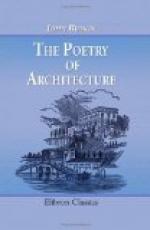121. There remains only one accusation to be answered; viz., that it hints at a paltry and unsubstantial material: and this leads us to the second question. Is this material allowable? If it were distinctly felt by the eye to be stucco, there could be no question about the matter, it would be decidedly disagreeable; but all the parts to which the eye is attracted are executed in marble, and the stucco merely forms the dead flat of the building, not a single wreath of ornament being formed of it. Its surface is smooth and bright, and altogether avoids what a stone building, when not built of large masses, and uncharged with ornament, always forces upon the attention, the rectangular lines of the blocks, which, however nicely fitted they may be, are “horrible! most horrible!” There is also a great deal of ease and softness in the angular lines of the stucco, which are never sharp or harsh, like those of stone; and it receives shadows with great beauty, a point of infinite importance in this climate; giving them lightness and transparency, without any diminution of depth. It is also agreeable to the eye, to pass from the sharp carving of the marble decorations to the ease and smoothness of the stucco; while the utter want of interest in those parts which are executed in it prevents the humility of the material from being offensive: for this passage of the eye from the marble to the composition is managed with the dexterity of the artist, who, that the attention may be drawn to the single point of the picture which is his subject, leaves the rest so obscured and slightly painted, that the mind loses it altogether in its attention to the principal feature.
122. With all, however, that can be alleged in extenuation of its faults, it cannot be denied that the stucco does take away so much of the dignity of the building, that, unless we find enough bestowed by its form and details to counterbalance, and a great deal more than counterbalance, the deterioration occasioned by tone and material, the whole edifice must be condemned, as incongruous with the spirit of the climate, and even with the character of its own gardens and approach. It remains, therefore, to notice the details themselves. Its form is simple to a degree; the roof generally quite flat, so as to leave the mass in the form of a parallelopiped, in general without wings or adjuncts of any sort. Villa Somma-Riva [Carlotta] is a good example of this general form and proportion, though it has an arched passage on each side, which takes away from its massiness. This excessive weight of effect would be injurious, if the building were set by itself; but, as it always forms the apex of a series of complicated terraces, it both relieves them and gains great dignity by its own unbroken simplicity of size. This general effect of form is not injured, when, as is often the case, an open passage is left in the center of the building, under tall and well-proportioned




